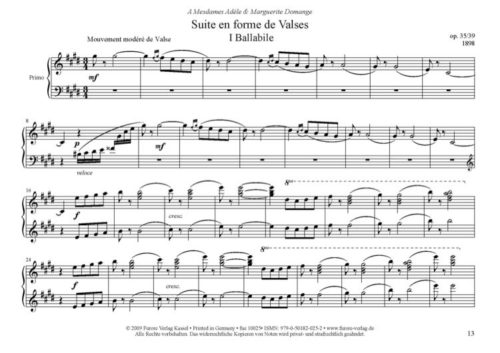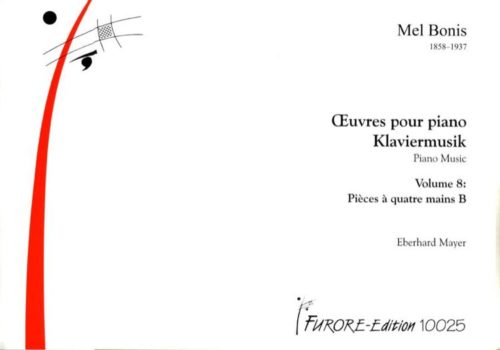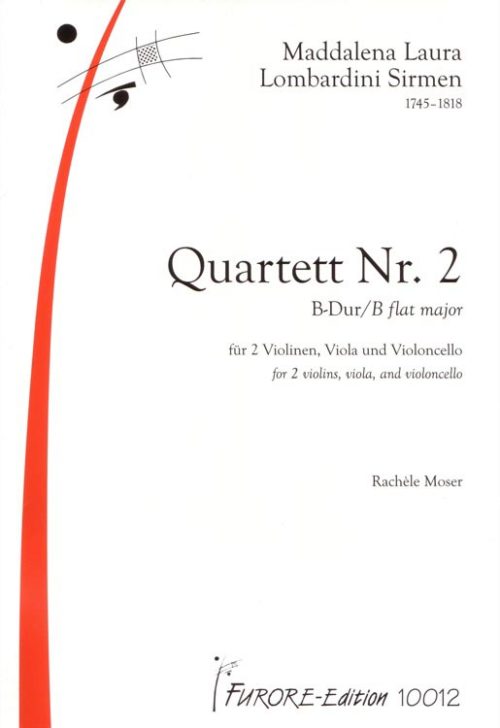Description
OEuvres pour piano/Klaviermusik/Piano Music
Edition en 10 recueils/Edition in 10 Bänden/Edition in 10 volumes
Vol. 6: Pieces à quatre mains A /4 hand pieces
Instrumentation: piano 4hands
Edition: score
Publisher: Eberhard Mayer
Difficulty: medium
Contents: Pavane op. 81/2
Six Valses-Caprice op. 87
Le Songe de Cléopâtre op. 180/1
The pieces for piano represent a great stylistic variety. One gets the impression that Mel Bonis may have intended to give a summary of musical development, not quoting historic styles but adapting the past through her personal tone and to translate it into contemporary musical language.
The first volume of the four-handed compositions by Mel Bonis contains three works: “Pavane”, “Six Valses-Caprice” and “Le Songe de Cléopâtre“ (“Cleo-patra’s dream”).
Pavane opus 81/2
“Pavane” belongs to a group of three dances (Bourrée, Pavane und Sarabande), which were published by Demets between 1904 and 1909. A version for solo piano and an orchestral version appeared at the same time. The manuscript of the solo piano version dates from 1903. “Pavane” was the only piece to be ar-ranged for piano for four hands. This version appeared in the magazine “L’Illustration” on 24 February 1906, i.e. three years before publication of the other versions by Demets. The pavane is actually a ceremonial courtly step dance from the 16th century. Mel Bonis, like many other composers of the “Belle Epoque”, drew upon the past, in keeping with the fashion of the times. The four-handed version of this dance “in the old style” brings out the interest-ing polyphonic form of the composition extremely well. The piece lasts a good three minutes and makes no particular technical demands. In the final edition, “Pavane” is dedicated to Edouard Domange, Mel Bonis’ youngest son.
Six Valses-Caprice opus 87
This comprises a group of six waltzes which – at one moment rousing, at an-other tender – are very contrasting in character. The popularity of these pieces with performers and audiences alike lies both in their accessibility and the rela-tively simple style and in their easily remembered melodies. The manuscript dates from 1910, the first edition by Poulalion in Paris from 1911. Mel Bonis dedicated the work to the “little Domanges”, i.e. the grandchildren of her hus-band Albert Domange.
Le Songe de Cléopâtre opus 180/1
This long piece in a much more complex and modern style forms an exception amongst all the composer’s four-handed works. It is an adaptation of an orches-tral score into a piece for four hands. “Cleopatra’s Dream” is one of three or-chestral pieces which we have collected under the title “Portraits of three women”. All the characteristics of the major works from the composer’s ma-ture period reappear here – her exquisite individually coloured harmonies, her rhythms full of longing, her sensuality, the inclination towards the exotic which can be glimpsed from time to time. “Le Songe de Cléopâtre” was not published during Mel Bonis’ lifetime, and there is no indication of the date of composi-tion either on the copy of the four-handed version or on the manuscript of the orchestral version. In view of the “modernity” of the style, however, we can assume that the work was composed after the First World War. This piece last-ing nine minutes requires that its performers possess empathy in interpretation and a reasonable level of technical ability.










